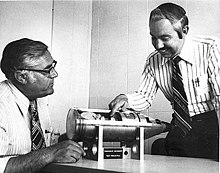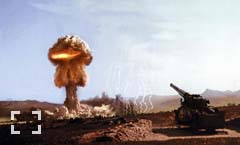 |
|
Atomic Annie

| |
Mockup W48 155mm artillery shell
|
Shortly after the creation of the first atomic bombs, the US became interested in weapons with 'limited' yield that could be used tactically, rather than strategically. One of the more interesting of these developments was atomic artillery, first tested in Nevada on May 25th 1953.
Some major design hurdles needed to be overcome to develop an artillery-fired atomic projectile (AFAP).
Nuclear weapons of the time were large, highly complex and delicate devices, intrinsically unsuited for
firing out of a cannon. An artillery shell is usually spun at up to 15,000 revolutions per minute for
stability, and subjected to crushing accelerations up to 18,000 times the force of gravity. Meaning the
device needed to have an absolute minimum of moving parts, and those that were included needed to be
extremely shock resistant.
After an intensive period of development, Robert Schwartz released the first AFAP designated "TX-9" from the Army's Picatinny Arsenal in Dover. In its simplest form, the shell was a 'gun-type' weapon, except with sufficient ruggedness to withstand the stress of being launched from a gun barrel. Utilizing highly enriched uranium in one large ring assembly, and one smaller "bullet" fired down a tube into the ring assembly to achieve critical mass. The forces of setback, the movement of internal components toward the rear of shell when fired, and spin, were used to arm the device when the shell was fired.
The W-9 finally contained more than 60 kilograms of oralloy; its predicted yield was only 15 KT, but its
nuclear efficiency was less than two percent. By comparison, nuclear efficiency of contemporary implosion
bombs was between 25% and 35%. This inherent inefficiency meant that this weapon was extremely expensive in relation to it's yield.

| |
M-65 280mm field artillery piece
|
The largest field artillery piece available at the time was the 240 mm howitzer, too small to accommodate
the new weapon. This requirement led to the development of the M-65 280mm Nuclear Field Artillery piece, nickname, "Atomic Annie". The name was probably chosen with reference to "Anzio Annie" a German railroad gun that battered the Anzio beachhead during 1944.
The gun travelled suspended between the front and rear custom transporter tractors, each with its own 365 hp engine, independently driven much like an aerial ladder fire truck. The speed of the transporter on the open road was about 30 mph, but its weight of 76 tons precluded it from crossing unreinforced bridges or driving on soft roads.
Once deployed, the gun sat on a turntable pedestal and three jacks. The tremendous firing forces were
absorbed by a double recoil system. Both the gun tube and the heavy carriage moved separately with the
recoil, reducing the overall recoil distance to a minimum. This system removed the requirement for any
prior excavation work reducing setup time.
The scientists at Los Alamos had originally wanted to tower test the Mk-9 shell. A static test would
enable more precise measurements of the device in operation. Collection of this data from a spinning,
encased device travelling at several hundred meters per second was considerably more difficult. Although
standard measurements could be done, the shell would need to be detonated at no more than 150 meters.
However, the Joint Chiefs of Staff (JCS) concluded that substantial benefits would accrued from a full-
scale nuclear test of the MK 9/280MM gun delivery system, before its deployment to "vital areas", namely
Korea.

| |
Crew taking cover before firing
|
Two 280mm cannons were taken by rail from Oklahoma, to the Nevada test site 65 miles North of Las Vegas. The cannons were then emplaced side-by-side on a flat area 11 km south of Frenchman flats by an artillery battalion who had been specifically trained for the task at Fort Bliss in Texas.
The assembly and preparation for firing took only an hour, including time for insertion of nuclear
components into the shells, and manual setting of the height of burst fuse. In spite of this, the gun
would later be criticized for being too vulnerable to air attack or artillery counter-battery fire. This
was compounded by the requirement for several adjustment and registration (spotting) rounds to be fired
prior to the main shot, to zero-in the gun.
The crew then took position in trenches or behind barricades, before firing the cannon remotely at 08:30
hours local time. The shot was designated Grable (mnemonic code for gun), the tenth atmospheric test shot of Operation Upshot-Knothole.
The shell travelled 10,000 meters before detonating 26 meters west, 41 meters south and 7 meters above
what had been the intended burst point. It achieved a nominal yield of 15 kilotons, the same explosive
force as the three meter long, four ton Little Boy bomb dropped over Hiroshima nearly eight years earlier.

|
|
Shot "Grable" - Yield 15Kt
|
As the initial flash subsided, a unique phenomena was observed. The fireball had split into two separate
halves, in effect a 'double fireball'. This unexplained phenomenon was not seen again until 4 years later with shots Priscilla and Owens during Operation Plumbbob.
The second anomaly was the formation of a precursor, a second shock front ahead of the incident wave. Formed as the shock wave reflected off the ground and surpassed the incident wave and Mach stem. It resulted in a lower overpressure, but higher overall dynamic pressure, inflicting far greater damage on drag sensitive targets. Far greater in fact than the previous shot Encore, which had been nearly twice the yield.
The low burst height (necessitated by the difficulties of gathering test data from an artillery shell), and the dust laden layer of heated air close to the ground (known as "popcorning"), were also significant contributors to this anomalous increase in destructive blast effects. This lead to a complete re-calculation of existing blast-curve data, and strategists to rethink the importance of low air bursts in tactical nuclear
warfare. These phenomena were investigated in full later during shot MET of operation Teapot.

| |
Precurser wave video
|
700 DOD personnel, including the Secretary of Defence and several congressmen witnessed the shot from an area about 11 km north of ground zero. The test was also experienced by 2,600 troops stationed in trenches 4.5 km west of ground zero, as participants of exercise Desert Rock V. These troops then attacked two targets 2.5 km from ground zero, but were forced back by high winds and dust.
The test of the 280MM cannon no doubt impressed the North Korean and Chinese governments, who were in the process of concluding an armistice with United Nations forces in Korea during the Upshot-Knothole series in the spring of 1953. (During the 16th century, the "upshot" was the final shot in an archery
tournament.)
After the test Sterling Cole, the Chairman of the congressional Joint Committee on Atomic Energy, stated:
"In order to understand the military importance of our progress, one has only to recall that the 1945 bomb
was so big as to require four-engine B-29 bomber to carry it to Hiroshima and Nagasaki in World War II.
The projectile fired in today's test was just over 11 inches in diameter. They have concentrated into
capsule form what once filled an entire bomb bay.. We have added another major weapon to our stockpile."
Approximately 80 MK-9 shells were produced between April 1952 and November 1953. Though the Mk-9 was superceded by more advanced designs, all were eventually withdrawn from the stockpile as well as the twenty cannons that had been built at a unit cost of $800,000 each.
Four 280mm cannons still exist in various locations throughout the US. Atomic Annie is located at Fort
Sill, the other three are at the National Atomic Museum in Albuquerque, New Mexico; Fort Riley, Kansas
and Aberdeen Proving Ground in Maryland.
|
|
|
 |





